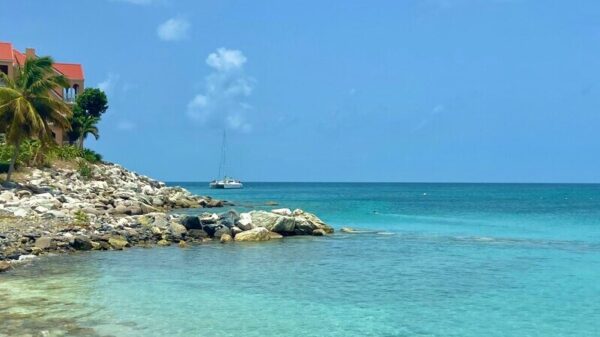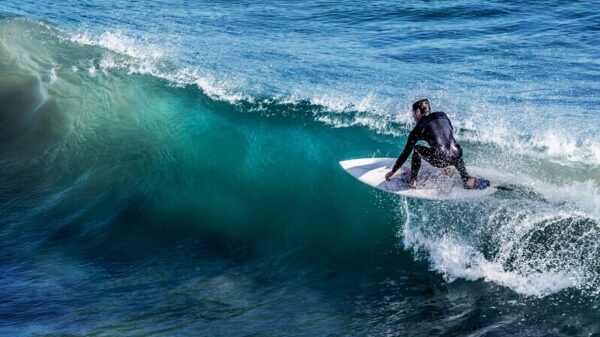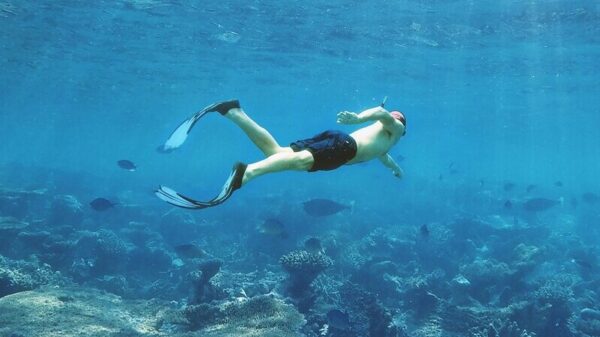This page contains affiliate links marked with an asterisk (*). If you decide to make a purchase after clicking on a link, we may receive a commission at no additional cost to you.
Beautiful Curaçao: Watching Turtles at Playa Grandi
If you want to observe turtles in Curaçao, Playa Grandi, also known as “Playa Piskado”, is the most popular spot. You will almost certainly encounter the endearing marine animals while snorkeling. The beach, along with Grote Knip and Mambo Beach, is among the most popular beaches on the island. It is located in the southwest, about 45 kilometers from Willemstad, the capital of Curaçao.
Since some fishermen dispose of part of their fishing waste in the water, many fish and turtles live in the sea at Playa Piskado, gathering around the easy prey. To be able to admire the animals underwater, we recommend you bring a snorkeling set*. This way, you get enough air under the water surface and have an ideal view of the bustling underwater world with the swimming goggles*.
For vacationers who prefer to snorkel with professional guides, guided excursions are recommended. On a tour to Playa Piskado you will first visit some beaches of the island and have the opportunity to admire the nature of the island during the drive. Playa Piskado is the last stop of the tour. There you will have plenty of time to swim and snorkel and admire the underwater world. Note that you must bring your own snorkeling gear* and food, but drinks are included in the price of the tour.
Curaçao – Three Turtles Compared
To help you distinguish the adorable marine animals, we provide you with useful information. Common in Curaçao are particularly the hawksbill turtle, the false hawksbill turtle, and the green sea turtle. All three species are classified as endangered, as they are, for example, victims of illegal wildlife trade. Therefore, appropriate handling of these beautiful marine inhabitants is especially important. More information on how to interact with the turtles in Curaçao can be found in our tips below.

#1 Curaçao Turtles: The Green Sea Turtle
The green sea turtle, also known as the “soup turtle,” is the most common species in Curaçao. This turtle is endangered due to various factors, including beachfront development, climate change, and the increasing pollution of the oceans with plastic and fishing nets.
Native to tropical and subtropical oceans worldwide, the green sea turtle primarily feeds on algae and seagrass and is therefore mostly found in shallow waters.
Including tail and head, the green sea turtle reaches a size of 4,9 feet and can weigh up to 551 pounds. Normally, these animals live for 40 to 50 years, but they can also reach an age of up to 80 years.
The shell itself can reach a length of up to 4.6 feet. The top has an olive green, brownish coloration with sometimes slight speckles. In contrast, the underside of the shell is colored yellow.
#2 Curaçao Turtles: The Hawksbill Turtle
The Hawksbill Turtle, also known as the “true hawksbill turtle,” is also among the endangered species. They are primarily found in the marine areas of tropical and subtropical zones, including the southern Caribbean Sea. The hawksbill turtle reaches a size of 2 to 3 feet and weighs about 110 to 154 pounds.
The narrow, pointed shape of the head characterizes the hawksbill turtle. A distinctive feature of the hawksbill turtle is also its beautiful shell with its striking mottling. This consists of black, brown, amber, orange, red, and yellow tones. Just this shell was a threat to hawksbill turtles in the past. Poachers used the shell for souvenirs, jewelry, and other items. This explains the low worldwide population of the species.
#3 Curaçao Turtles: The Loggerhead Turtle
The loggerhead turtle, also known as the “false hawksbill turtle,” is probably the most well-known type of sea turtle. Although the loggerhead turtle is not classified as endangered in all oceans, it is still considered threatened worldwide.
In direct comparison to the true hawksbill turtle, this species has a significantly larger head, which explains the name “loggerhead turtle.” In addition to a more substantial head size, the loggerhead turtle also has a more prominent jaw.
With a maximum length of one meter and a weight of 198,5 to 352,7 pounds, it is slightly smaller than the other two turtle species. However, the loggerhead turtle can be recognized not only by its size but also by the slightly heart-shaped shell and its red-brown coloration.
Like the true hawksbill turtle, the loggerhead turtle is an omnivore, feeding on both animal and plant matter.

Tips for Interacting with Turtles in Curaçao
When you swim in the turquoise sea, you are entering the natural habitat of the turtle, their home. Responsible interaction with the animals is therefore essential. Make sure not to crowd the turtles or touch them. Even if they may seem approachable, they can snap at you if they feel threatened. This can also happen if you follow them or disturb a resting turtle. Close contact with humans can stress the marine animals, even if it’s not immediately apparent to people.
Also, feeding the turtles should be avoided at all costs. They are capable of finding their own food and could accidentally bite you while eating. When swimming, also make sure that you are not directly above the turtles. This can obstruct their view and possibly prevent them from reaching the water’s surface to breathe. Although they can stay underwater for extended periods, they need fresh oxygen, just like humans.
Conclusion: The Turtle Paradise of Curaçao
At Playa Grandi in Curaçao, you have an almost one hundred percent chance to observe turtles in their natural habitat. Snorkel peacefully through the Caribbean, turquoise blue sea, and watch the lovely marine inhabitants feeding.
Also, at other beaches, such as Playa Lagun, Caracasbaai, and Playa Cas Abao, you might have the chance to meet the adorable turtles. This makes the Caribbean island an ideal vacation destination for animal lovers and turtle enthusiasts. The colorful variety of species and the stunning underwater world make visiting the island an unforgettable experience.







